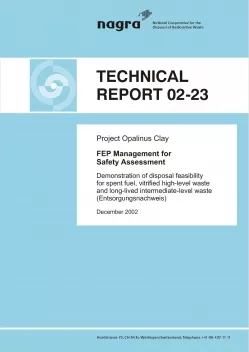
Technical Report NTB 02-23
Project Opalinus Clay: FEP Management for Safety Assessment – Demonstration of disposal feasibility for spent fuel, vitrified high-level waste and long-lived intermediate-level waste (Entsorgungsnachweis)
The aims of and the approach used in the FEP management process are:
- The FEP management process has to consider and reflect the approach used by science to describe a disposal system and the approach used when modelling the system as described by science.
− Science describes its findings with respect to the system and its behaviour and evolution "as a whole", which results in the identification of a set of key safety-relevant phenomena, their expected evolution and associated uncertainties, and possible deviations with respect to the expected evolution.
− Modellers abstract and fragment the description by science into building blocks that form a suitable basis to develop and apply corresponding quantitative models. This results in a description of the system and its evolution in terms of Super-FEPs (as groupings of more detailed FEPs) with a reference realisation and alternative realisations to reflect the uncertainties identified by science.
− To ensure that the modellers have considered all the information (and uncertainties) identified by science, a check is made that, for each of the key safety-relevant phenomena, at least one corresponding Super-FEP exists; this also includes the corresponding uncertainties. At the same time, a check is made that for each Super-FEP, a corresponding key safety-relevant phenomenon exists that justifies the inclusion of the Super-FEP in the modelling approach.
− The FEP management process also keeps track of the reserve FEPs (FEPs that are considered likely to occur and to be beneficial to safety, but which are deliberately excluded from the assessment cases), and of outstanding issues with the potential to compromise safety (if there are any). - The FEP management process has to ensure that a sufficiently broad set of assessment cases is analysed by suitable tools (assessment codes).
− The Super-FEPs and their realisations are assessed with respect to their relevance to safety and – if considered relevant – are identified for inclusion into one or more assessment cases. The grouping of the different Super-FEPs and their realisations into assessment cases is carried out by looking at their effects on the broad behaviour / evolution of the system, including a check of the effects of the interaction between individual Super-FEPs. Assessment cases addressing similar effects are grouped together into specific scenarios. Cases within a scenario are distinguished by the different conceptualisations of one or more key phenomena or – if the conceptualisation of phenomena is the same – by variations of one or more model parameters.
− The adequacy of the tools used for the quantitative analysis of the different assessment cases is carried out through a qualification of codes (in general terms and in terms of Super-FEPs) and a check that the codes applied to analyse a specific case are actually able to reflect all the safety-relevant aspects of the Super-FEPs that are contained within this case. - The FEP management process has to take all reasonable measures to ensure completeness.
− At the start of the analysis, an Opalinus Clay FEP Database (OPA FEP Database) that contains all safety-relevant issues is developed. Completeness is ensured through auditing the OPA FEP Database against International FEP Databases that were developed for this purpose; i.e. for each FEP contained in the International FEP Data bases, it is checked whether it is included in the OPA FEP Database, and if not, that an explanation is available why not.
− Throughout the process of screening of irrelevant information and abstraction of the remaining information, audits and checks of the intermediate information databases (safety-relevant phenomena, Super-FEPs, assessment cases) against the OPA FEP Database are performed; i.e. for each of the FEPs contained in the OPA FEP Database it is checked if it is included in the database audited or if an explanation / justification exists why not.
This process resulted in a set of information (documented in different tables) that is compiled and described in the present report. There is some degree of overlap with other reports; i.e. some of the tables appear in other reports as well as in the present report. The development of this information and the corresponding tables was highly iterative, thus the final results as described in this report only reflect the interrelation between the different pieces of information, without providing a chronological description of how they were derived.
